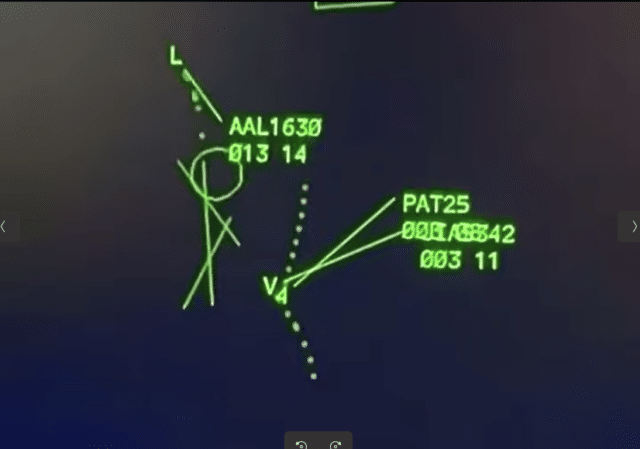A tragic mid-air collision took place near Washington DC on the 29th of January 2025. A Bombardier CRJ700, operating as American Eagle flight 5342 and a Sikorsky H-60 “Black Hawk” military helicopter crashed into each other at around 200 to 300 feet above ground level over the Potomac River.

Flight 5342 was a scheduled domestic passenger flight from Wichita, Kansas on final approach for runway 33 at Ronald Reagan Washington National Airport (DCA). , The CRJ700, registered in the US as N709PS, carried sixty passengers and four crew
According to FlightRadar24, the last data received from the aircraft was for level flight at 400 feet.
The weather at the time was with a westerly wind with ten miles visibility.
The US Army helicopter, registered as 00-26860, departed from Davison Army Airfield on a training mission. There were three on board, a captain, a chief warrant officer 2 and a staff sergeant. They were were flying south along the Potomac River as a part of an annual proficiency flight and night evaluation. The maximum allowed altitude for the route that the helicopter was travelling, transiting from route 1 to route 4, was 200 feet above ground level.
The collision took place at 20:48 local time (01:48 UTC) and has been reported at less than 200 feet altitude. Over three hundred responders were deployed, fighting against the icy conditions. There were no survivors.
The above ATCLive recording is a merge of two frequencies so that the aircraft and the helicopter interactions are audible at the same time. You can also listen to the two separate frequencies on VASAviation. The New York Times report that the two controller roles are usually merged at 21:30 but were merged earlier that day, with one controller managing both frequencies, as the controller needed to leave early.
The initial back and forth the Tower controller and flight 5342 were standard for the approach. American 3130 and American 427 were also on approach behind the accident aircraft.
The relevant interactions start with the controller warning the helicopter about the descending flight.
Tower Controller: PAT25, traffic just south of the Woodrow Bridge, a CRJ at 1,200 feet setting up for runway 33.
Helicopter: PAT25 has the traffic in sight. Request visual separation.
Tower Controller: Visual separation approved.
Tower Controller: PAT25, do you have the CRJ in sight?
Tower Controller: PAT25, pass behind the CRJ.
Helicopter: PAT25 has the aircraft in sight, request visual separation.
Tower Controller: Vis[ual] sep[aration] approved.
Unidentified Pilot in the air: Tower did you just see that?
Tower Controller: American 427, American 3130, go around. Turn left, heading 350, climb and maintain 3,000 foot.
It is yet unclear exactly how they ended up in conflict. The helicopter crew’s request for visual separation shifts responsibility to the helicopter crew to see and avoid the aircraft. The controller gave a specific instruction to the helicopter to pass behind the aircraft after agreeing to visual separation. The helicopter crew’s second request for visual separation may indicate that the helicopter did not intend to pass behind the landing aircraft, as that request was not acknowledged. They obviously believed that they had the CRJ700 in sight but with three aircraft inbound to DCA, a key question will be which aircraft did the helicopter crew actually have in sight.

This Google Earth image posted without attribution on the New York Times claims to show the flight path of the CRJ700 passenger jet, coming in from the top right, and the helicopter, travelling left to right.
This video by Captain Steeeve breaks down the ATC communications; I’ve jumped ahead to the Ground Frequency transmissions after the crash which I found particularly interesting.
Note that the helicopter did not necessarily have a Traffic Control Avoidance System (TCAS) installed, while the CRJ700’s TCAS would have been inhibited as it descended through 1,000 feet above the ground 400 feet above the ground (see comment below from Philippe).
. This is to avoid constant warnings with aircraft nearby and on the ground, which in heavily trafficked areas quickly turn TCAS warnings into a distracting nuisance. In addition, TCAS offers resolution advisories meant to be followed at altitude and could lead to an aircraft descending too close to the ground. Air Traffic Control and visual separation are generally more reliable at low altitudes.
This is Earthcam footage looking southwest, showing the impact:
The NTSB’s media briefing confirmed that taking part in the investigation are:
- TSB Canada
- MHIRG (previously known as Bombadier)
- PSA Airlines
- GE Aerospace
- Sikorksy
- FAA
- NATCA (representing air traffic controllers)
- ALPA (representing pilots)
- AFA (representing cabin crew)
- US Army
Since then, the NTSB has confirmed that the flight data recorder and the cockpit voice recorder from the CRJ700 have been recovered. The recovery teams are still searching for the helicopter’s recorder.
Most of the rest of the briefing was spent asking press not to speculate on causes and that the NTSB will of course be considering all aspects including human factors.
Despite this careful approach, US President Donald Trump speculated that the crash was somehow caused by DEI (diversity, equity, inclusion) hiring, implying fault with the air traffic controller. However, when asked whether there was any evidence to support this claim, he said “It just could have been.” He backed this assertion with “I have common sense” and claimed that the Obama administration thought that personnel were “too white”. The Washington Post published a fact check which refutes Trump’s claims and details the actual FAA hiring practices under Obama, Trump and Biden.
The New York Times reported that the tower at Reagan airport has been understaffed for years and that an internal FAA report said that the staffing was “not normal for the time of day and volume of traffic”. On the ATCLive recording, it’s clear that a single controller was dealing with arriving and departing aircraft as well as local helicopters on a different frequency. According to the New York Times, one controller left early and the supervisor combined the two roles, leaving the one controller to deal with the evening traffic.
This crash ends a sixteen-year streak without a fatal US commercial airline crash. The previous fatal crash was Colgan Air flight 3407 in 2009. Key factors in this investigation will likely include the responsibility for separation and conflicting expectations of flight paths. The NTSB have confirmed that they will release a preliminary report in thirty days. Their investigation will be crucial in determining the exact sequence of events and digging past the obvious to identify the underlying causes.



